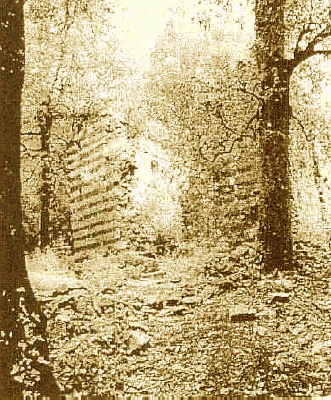Contenuto
Percorso : HOME > English > Pilgrims > MontespecchioMontespecchio: hermitage and church

Montespecchio: hermitage and church
Montespecchio: hermitage and church
Montepiscini is a very small Tuscan town, located approximately thirty five to forty miles south of Siena. This is where one must begin to visit what is the most difficult of the early Augustinian hermitages to reach. Beginning at Montepiscini, a pilgrim follows a dirt road into the hills, down into the woods by a steep path, eventually crossing a stream that cuts the trail in two. The ruins of the ancient Augustinian church are located approximately ten feci beyond the stream behind a few stender trees. It has no roof and its alternating black and salmon colored walls lean outwards. This eremetical foundation was already in existence at tbe time of the Little Union of 1244.
These ruins are not situated on a main road and it continues to be challenging to find the old hermitage. Yet in walking through the woods, a modern pilgrim gets a first hand experience of the way the thirteenth century hermits chose natural places which would allow for a peaceful setting for their life of prayer, penance and contemplation. The hermitage is situated down in a valley, near water, and indicates one of the main reasons that the hermits chose this location. Perhaps there was some kind of a main road nearby at that time; this is not the case today.
The religious community of Montespecchio does not nave any special history or famous names attached to it. However, there are a few known facts regarding this hermitage. It was founded on October 15, 1190, the date noted on a document attesting to the donation of the land to a certain Giovanni to build a hermitage there. It took him about ten years to construct the church and later a convento.
There is another record dated 1228 indicating that at that time, there was a community of six living at Montespecchio: two priests, Niccolo, the prior, and Ildebrando, and four lay brothers, Giovanni, Pietro, Giacomo and Guido. Montespecchio apparently always had a close relationship with Lecceto. In 1231, the names or their priors appear together on a letter requesting Pope Gregory IX to give them one or the accepted monastic rules of the time. Most likely, they received the Benedictine Rule. In 1244, Lecceto opted to become part of the Little Union of Tuscan hermitages and follow the Rule of St. Augustine, but Montespecchio did not choose to do so until 1255, a year before the Grand Union of many such hermitages. The hermitage of Monespecchio had its highs and lows. It enjoyed a reputation for hospitality, despite the fact this it always had a precarious economic situation. At times, it needed to be assisted by the archbishop of Siena which accounts for its occasional appearance in old records. Gradually it reached a low point when it was incorporated into the observant Congregation of Lecceto in 1433. In 1449, it was selected as the site for the General Chapter of all the observant congregations of the Order. During the sixteenth century, Montespecchio was the house for postulants, those seeking admission, to the Lecceto community of Augustinians. Possibly, it also served as the novitiate for a time. However, by 1687, its closing became inevitable.
The church and the convent were at the point of caving in to the degree that the community moved to the nearby church of Crevole. In 1782, Crevole itself was suppressed. Today, only the church with is French and Pisan influence and its spacious windows that indicate Gothic architecture remain. Upon closer inspection of the area to the left of the church, the outline of the enclosure walls and the walls of the convent are visible. Over time, the woods have taken over but corners soon appear and the visitor can see evidence of the beginning of a stairway as well as a passage from the convento to the church.
There are legends that are still told about this hermitage. It is called the 'conventaccio', the bad convent, because it is said that women of ill repute were brought there to do penance. As occasionai friar is said to have fallen from grace because of their presence! Even sightings of ghosts, 'white and silent', have been reported from time to time.

